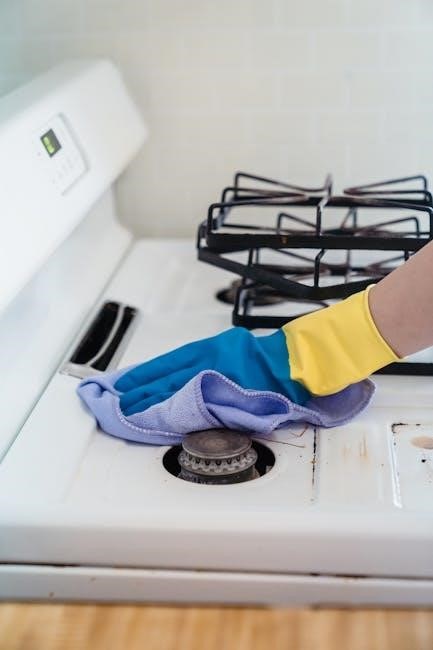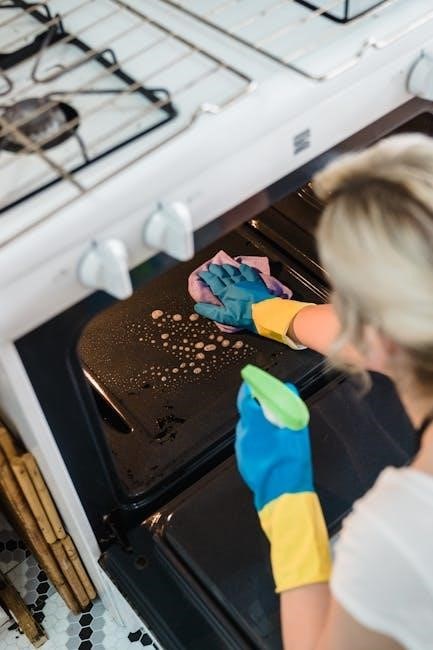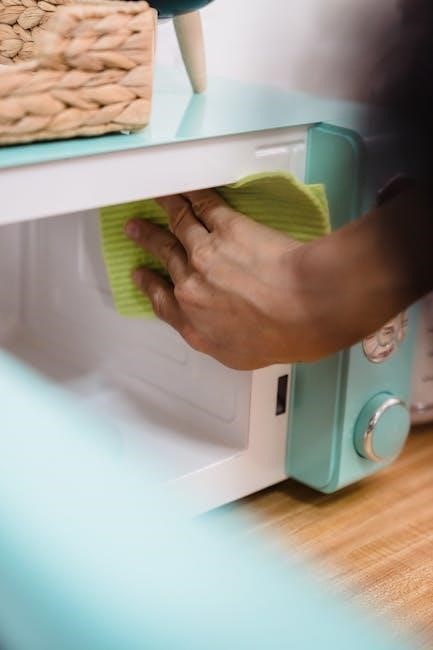The GE Profile Self-Cleaning Oven offers a convenient and efficient cleaning solution, utilizing high heat to burn food residue, leaving ashes easily wiped away․ Operate with caution for optimal results․

Overview of the Self-Cleaning Feature
The GE Profile Self-Cleaning Oven features a high-heat cycle designed to burn food residue into ashes, simplifying cleanup․ While convenient, concerns about its effectiveness and potential oven damage have been raised․ Proper preparation and adherence to instructions are crucial for safe and effective use․ The feature uses high temperatures to incinerate food residue, turning it into ash that can be easily wiped away․ However, appliance technicians have raised concerns about the long-term effects of such high heat on the oven’s components, including the control board and wiring․ Despite these warnings, many users find the feature convenient, provided they follow the manufacturer’s guidelines carefully․ It’s important to weigh the benefits against the potential risks to decide if using the self-cleaning mode is right for your oven․
Benefits of Using the Self-Cleaning Mode
The self-cleaning mode offers a convenient and efficient way to maintain your GE Profile oven․ It eliminates tough food residue through high heat, reducing the need for harsh chemicals or scrubbing․ This feature saves time and effort, as it handles heavy-duty cleaning automatically․ Additionally, it ensures a hygienic cooking environment by removing baked-on grime․ Regular use of the self-cleaning mode can also prevent the buildup of grease and food particles, which can affect oven performance over time․ While it requires proper preparation and precautions, the mode is a valuable tool for keeping your oven in optimal condition and extending its lifespan․

Safety Precautions Before Using the Self-Cleaning Oven
Always open windows for ventilation and ensure the kitchen is well-ventilated to avoid fumes; Wear protective gear like oven mitts and avoid leaving children or pets nearby․ Never start the cycle with a dirty oven, as food residue can emit harmful smoke․ Keep the oven empty and ensure all racks are removed․ Avoid using chemical cleaners before the cycle, as they can release toxic fumes when heated․
Important Warnings About Modern Ovens
Modern ovens, including the GE Profile self-cleaning model, require careful attention to safety guidelines․ High temperatures during the self-cleaning cycle can release toxic fumes from food residue, posing health risks․ Prolonged exposure to these fumes can cause respiratory issues, especially for those with pre-existing conditions․ Additionally, the intense heat can damage oven components or surrounding surfaces if improperly managed․ Always follow the manufacturer’s instructions to minimize risks․
Ensure the oven is empty of racks and accessories before starting the cycle, as these can warp or discolor․ Never leave the self-cleaning process unattended, as unexpected malfunctions can occur․ Proper ventilation and supervision are essential for safe operation․
Risks of High Heat and Long Cleaning Cycles
The GE Profile self-cleaning oven’s high heat function can pose risks, including potential damage to internal components if misused․ Extended cleaning cycles may warp racks or discolor surfaces․ Additionally, prolonged exposure to extreme temperatures can lead to energy inefficiency and increased utility costs over time․
Furthermore, high heat can release harmful fumes from burnt food residue, which may aggravate respiratory conditions if proper ventilation isn’t maintained․ Always ensure the kitchen is well-ventilated and avoid leaving the cycle unattended to prevent accidents or unexpected malfunctions․
Recommended Alternatives to Self-Cleaning
If you prefer to avoid the self-cleaning mode, there are effective alternatives to maintain your GE Profile oven․ Manual cleaning with a damp cloth or soft brush can remove light soil․ For tougher stains, a mixture of baking soda and water or a gentle cleaning solution can be applied․ Steam cleaning is another option, using a pan of water and vinegar to loosen grime․ Additionally, frequent wiping after use prevents heavy buildup․ These methods are eco-friendly and reduce wear on the oven, making them excellent choices for regular maintenance without extreme heat․

Preparing for the Self-Cleaning Cycle
Start by removing all racks and accessories to prevent damage․ Wipe heavy food residue with a damp cloth․ Ensure good ventilation by opening windows or using an exhaust fan․ Keep the area clear and avoid leaving the oven unattended․ Follow these steps to ensure a safe and effective cleaning process․
Removing Oven Racks and Accessories
Before starting the self-cleaning cycle, remove all oven racks, baking sheets, and accessories to protect them from high heat damage․ Place racks on a heat-resistant surface or wrap them in foil to prevent warping․ For racks with heavy buildup, scrub them with soap and water beforehand․ Ensure no aluminum foil or utensils remain inside, as they may melt or cause damage․ This step ensures a safer and more effective cleaning process․ Store removed items securely to avoid accidental damage or tripping hazards in the kitchen․
Wiping Up Heavy Soil Before Cleaning
Before initiating the self-cleaning cycle, remove large food debris from the oven floor and walls using a soft brush or plastic scraper․ This prevents residue from hardening further during high heat․ Avoid using metal scrapers, as they may scratch the oven surfaces․ For tough spots, dampen a cloth with water and gently wipe away loose particles․ Do not use abrasive cleaners or harsh chemicals, as they may damage the finish․ This step ensures the self-cleaning process works more efficiently and reduces smoke or fumes during the cycle․ It also helps prevent stubborn stains from forming․
Ventilating Your Kitchen
Proper ventilation is essential before and during the self-cleaning cycle to prevent fumes from lingering in your home; Open windows and doors to ensure good airflow․ Turn on exhaust fans, especially those above the oven or in nearby areas․ This helps remove smoke and odors caused by burning food residue․ For added ventilation, use portable fans to circulate air․ Avoid lingering in the kitchen during the cleaning process, as fumes can irritate eyes and respiratory systems․ Ensure all vents are clear and functioning properly to maximize airflow efficiency․ Proper ventilation ensures a safer and more comfortable cleaning experience․

Activating the Self-Cleaning Cycle
Press the Clean button, select the desired cycle duration using the keypad, and confirm․ The oven door will automatically lock during the cleaning process․
Step-by-Step Instructions to Start the Cycle
To begin the self-cleaning cycle on your GE Profile oven, press the Clean button on the control panel․ Use the keypad to select the desired cleaning duration, typically 2-4 hours․ Once selected, press the Start button to confirm․ The oven door will automatically lock to ensure safety during the high-heat cycle․ Ensure the oven racks and accessories have been removed beforehand․ The oven will heat to an extreme temperature, burning food residue into ash․ Monitoring the process is unnecessary, as the oven operates automatically․ Let the cycle complete before opening the door or wiping down the interior․
Using the Control Panel to Set the Cleaning Duration
Operating the GE Profile self-cleaning oven involves using the control panel to select the cleaning duration․ Press the Clean button to activate the self-cleaning mode․ Use the keypad to choose the desired cleaning time, typically 2, 3, or 4 hours, depending on soil level․ Press the Start button to confirm your selection․ The oven door will automatically lock once the cycle begins․ The control panel will display the remaining time and status updates․ Ensure all racks are removed before starting, as high heat may warp them․ The oven will emit intense heat to burn food residue into ash, simplifying cleanup after the cycle completes․
Ensuring the Oven Door is Closed and Latched
Before starting the self-cleaning cycle, ensure the oven door is completely closed and latched․ This is a critical safety feature to prevent heat from escaping and to avoid accidental burns․ Check that no items, such as oven mitts or towels, are obstructing the door․ The door will automatically lock once the cleaning cycle begins to maintain high internal temperatures․ If the door is not properly latched, the cycle may not start․ Always verify the door’s position and latch before pressing Start․ This ensures safe and efficient operation of the self-cleaning function and prevents damage to the oven or surrounding areas․

Post-Cleaning Maintenance
After the self-cleaning cycle, allow the oven to cool completely․ Wipe away ashes and residue with a damp cloth․ Regular light cleaning prevents heavy build-up․
Allowing the Oven to Cool Down Completely
Letting the oven cool down completely after the self-cleaning cycle is essential for safety and maintenance․ High heat can damage components if the oven is used immediately․ Allow it to cool naturally for several hours to prevent overheating and ensure all residues settle properly․ This step also helps avoid burns when handling the oven․ Do not open the door during cooling, as this can disrupt the process and leave ashes scattered․ Patience ensures the oven remains in good condition and ready for future use․
Wiping Away Ashes and Residue
After the self-cleaning cycle and cooling, put on gloves to protect your hands from sharp debris․ Use a damp cloth or sponge to wipe away ashes and residue from the oven walls, floor, and racks․ For stubborn spots, a soft-bristled brush can help loosen particles․ Avoid using abrasive cleaners or scouring pads, as they may damage the oven’s finish; If needed, mix a small amount of mild soap with warm water for a final wipe-down․ Dispose of the residue carefully and rinse the cloth thoroughly․ This step ensures your oven is clean and ready for its next use․
Regular Cleaning to Avoid Heavy Build-Up
Regular cleaning is essential to prevent heavy build-up in your GE Profile oven․ After each use, wipe down the oven walls, floor, and racks with a damp cloth to remove food residue․ For tougher spots, mix equal parts water and mild soap, apply the solution, and let it sit for 10-15 minutes before wiping clean․ Clean racks separately in warm soapy water․ Avoid using harsh chemicals or abrasive cleaners, as they may damage the oven’s finish․ Regular maintenance ensures the self-cleaning feature works efficiently and reduces the need for frequent deep cleans․ This routine keeps your oven in optimal condition․
Troubleshooting Common Issues
Identify and resolve issues quickly․ Check power supply, ensure the oven preheats correctly, and verify error codes․ Consult the user manual for specific solutions or contact support․
What to Do If the Oven Door Latch Doesn’t Lock
If the oven door latch fails to lock, ensure the door is properly aligned and free from obstructions․ Clean the latch area to remove grease or food residue․ Check for worn or damaged parts and replace them if necessary․ Avoid forcing the latch, as this may cause further damage․ If the issue persists, consult the GE Profile oven manual or contact customer support for professional assistance․ A malfunctioning latch can prevent the self-cleaning cycle from starting or functioning safely, so addressing this issue promptly is essential for proper oven operation․
Fixing the Thermal Fuse or Control Board
If the thermal fuse or control board malfunctions, the self-cleaning cycle may not activate․ First, check for error codes on the display panel to identify the issue․ Disconnect power to the oven before attempting repairs․ Inspect the thermal fuse for visible damage or wear․ If damaged, replace it with a compatible part․ For control board issues, verify connections and look for signs of burnout or corrosion․ If unsure, consult a professional technician to diagnose and repair the problem․ Proper function of these components is critical for safety and performance during the self-cleaning process;
Addressing Damage from Self-Cleaning Mode
If damage occurs during the self-cleaning cycle, inspect the oven for discoloration, warped surfaces, or cracked glass․ High heat can cause racks and accessories to degrade, so ensure they are removed before cleaning․ Fumes from food residue may also damage finishes․ For minor damage, replace affected parts like racks or shelves․ For major issues, such as warped walls or damaged glass, contact a professional․ Avoid using abrasive cleaners, as they can harm the oven’s finish․ Always follow the manufacturer’s guidelines to prevent damage․ Regular maintenance and proper use can extend the life of your GE Profile self-cleaning oven․

Alternative Cleaning Methods
For lighter cleaning or to avoid high heat, consider using a 50/50 water and vinegar solution, steam cleaning, or effective oven cleaning chemicals․


Using a 50/50 Water and Vinegar Solution
Mix equal parts water and white vinegar in a spray bottle․ Apply the solution to the oven interior, focusing on soiled areas․ Heat the oven to 200-250°F for 30 minutes to loosen grime․ Let it cool slightly, then wipe down surfaces with a damp cloth․ This eco-friendly method is gentle on surfaces and avoids harsh chemicals․ Avoid letting the solution sit too long, as it may leave residue․ For tougher stains, repeat the process or let it sit longer․ Always ventilate your kitchen to prevent strong vinegar fumes and wear gloves for protection․
Effective Oven Cleaning Chemicals
For tough grease and grime, consider using heavy-duty oven cleaners like Easy-Off or OxiClean․ These products break down stubborn stains effectively․ Always wear gloves and ensure good ventilation․ Apply the cleaner as directed, avoiding the heating elements or glass․ Let it sit for the recommended time before wiping clean with a damp cloth․ For a gentler option, eco-friendly cleaners like Seventh Generation or Ecover are suitable․ Follow the product instructions carefully to avoid damaging the oven’s finish․ Regular use of these chemicals can maintain your GE Profile oven’s cleanliness without relying on the self-cleaning mode․ Always rinse thoroughly to remove residue․

Steam Cleaning for Light Soil
Steam cleaning is a gentle and chemical-free method for light soil․ Place a heat-safe bowl of water in the oven and heat it at 350°F for 20-30 minutes․ The steam loosens food residue, making it easy to wipe away․ For tougher spots, add white vinegar or lemon juice to the water․ After cooling slightly, use a damp cloth or sponge to clean surfaces․ This method is ideal for minor messes and avoids harsh chemicals․ Regular steam cleaning can help maintain your GE Profile oven’s interior without extreme heat or long cycles․ It’s a sustainable and efficient alternative for light cleaning needs․
Regular maintenance and proper use of your GE Profile oven ensure longevity and performance․ Follow guidelines for self-cleaning and alternative methods to keep it in top condition․
Final Tips for Maintaining Your GE Profile Oven
To keep your GE Profile oven in excellent condition, clean up light soil regularly to avoid heavy buildup․ Use the self-cleaning feature sparingly and only when necessary․ Always wipe down racks before placing them back in the oven․ For tougher stains, consider using a gentle cleanser or a 50/50 water and vinegar solution․ Avoid harsh chemicals that could damage the finish․ Check your oven racks periodically for wear and tear․ Refer to your user manual for specific guidance on error codes or unusual behavior․ By following these tips, you’ll extend the life of your oven and ensure optimal performance․
When to Avoid Using the Self-Cleaning Feature
Avoid using the self-cleaning feature if your oven has heavy soil buildup, as it may not handle large amounts effectively; Do not use it if you or family members are sensitive to strong odors or fumes․ If your oven is damaged, such as a broken door seal or cracked glass, self-cleaning can worsen the issue․ Avoid frequent use, as high heat cycles can reduce the oven’s lifespan․ If you prefer eco-friendly cleaning or are short on time, consider alternative methods․ Always refer to your GE Profile oven’s manual for specific guidance on when to avoid self-cleaning․